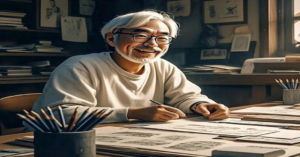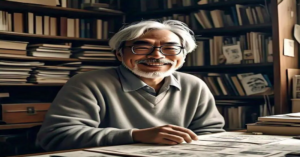Hayao Miyazaki the wind rises
Hayao Miyazaki: The Essence of Humanity and Dreams Turned Reality

There are few names in animation that inspire as much reverence as Hayao Miyazaki. From hand-drawn magic of My Neighbor Totoro to the ersatz existentialism of Prince Mononoke to the Oscar-winning Spirited Away, Miyazaki’s mastery transcends age, region, and even that which lives within the black lines of the daydream and the dream itself. He doesn’t animate stories so much as dream them into being, providing portals into densely textured worlds that feel a lot like ours but are also a lot more enchanted.
This blog is dedicated to charting Miyazaki’s growth and career as a filmmaker, his themes, aesthetic, philosophies and his never-ending influence from Studio Ghibli.
Hayao Miyazaki: The Origins of a Visionary
Hayao Miyazaki Early Influences
Miyazaki was born in 1941 in wartime Tokyo and grew up in a Japan that, like much of the rest of the world, was marked by disruption, homelessness and the visceral knowledge of death. These things creep up on you in many of his films, whether it be war-torn devastation or the fragile divide between nature and manmade.
His father was employed by a company that manufactured parts for airplanes, implanting in Miyazaki a lifelong love of flight — a recurring theme in his works, from “Nausicaä of the Valley of the Wind” to “Porco Rosso.”
Hayao Miyazaki From Animator to Auteur
Miyazaki’s animation career started in the 1960s at Toei Animation, where he worked as an in-betweener but soon proved himself as a storyteller. With Isao Takahata, his creative partner and co-founder of Studio Ghibli, he would work on Future Boy Conan, Heidi, Girl of the Alps and more. But it was Nausicaä (1984), based on his own manga, that established his reputation and served as the prologue to Ghibli.
The Films of Studio Ghibli: Hayao Miyazaki

A New Chapter in Animation
Founded in 1985, Studio Ghibli emerged from a shared dream to create auteur-driven, high-quality animation in an industry frequently characterized by formula. Under Miyazaki’s leadership, Ghibli would be synonymous with lush hand-drawn worlds, complicated female leads, and moral grayness.
To Exercise Creative Control and Be True to the Art
Unlike many a commercial studio, Ghibli operates more as a film auteur’s atelier than a mass production pipeline. Miyazaki is famously hands-on with every part — from storyboarding to character design to music and editing. He’s a perfectionist: His method may take longer—which explains the long gestation periods between albums or songs. But he consistently produces timeless art.
Themes That Animate the Heart
Environmental consciousness and the Tenuous Balance
One of the most recurring themes in Miyazaki’s movies is his ecological consciousness. In Princess Mononoke, the battle between human industry. Forest spirits is not just about good and evil, but about how to coexist. Nausicaä, too, foresees a world choked by pollution. But where the heroine seeks harmony, not domination.
Hayao Miyazaki : Pacifism and the Cost of War
Miyazaki, a vocal pacifist, includes anti-war themes in numerous of his works. Howl’s Moving Castle, for example, denounces the pointlessness of war with visual panache and emotional nuance. The war is not a glory — it is a lament.
The Other World and the Philosophy of the Shintô Motoworship of the Japanese and Koreans.
Movies like Spirited Away and My Neighbor Totoro offer a Shinto-informed view of the world, in which spirits live in all things, from rivers to soot. This animistic belief gives his stories a spiritual texture, in which children don’t so much navigate fantasy as learn from it.
Strong Female Protagonists
As opposed to many of the mainstream storylines, Miyazaki’s stories are frequently about spirited and self-sufficient young women. Chihiro and (Spirited Away), Kiki and (Kiki’s Delivery Service), and San (Princess Mononoke) stand for resilience, learning, and moral action. They’re not waiting to be rescued — they’re the rescuers.
Crafting the Visual Language
Bringing the digital age to hand-drawn beauty
He has been an insurgent promoting hand-drawn animation in an age of CGI. His films are a visual delight — every frame a painting, each background packed with detail. Whether it’s a castle in the sky that sails across a meadow or a bathhouse teeming with spirits, his images have an organic warmth that digital animation frequently fails to capture.
Miyazaki’s Use of “Ma”—The” Space Between
Among his most praised features is his use of “ma” (空) – the distance between people and or objects, and he was increasingly recognized throughout his career for this particular emphasis. These moments, when a character is breathing, just looking, just being, provide his films with a lyrical rhythm and emotional depth that is conspicuously absent from the frantic pace of most Western animation.
Silence as an Emotion Story
In Totoro, for example, long stretches of quiet aren’t narrative doldrums — they’re times for tourists to plunge into a character’s sensations. The wind in the trees, the rustling grass, the chime of distant bells — it all helps the audience feel the world, not simply watch it.
Cultural legacy and worldwide recognition
Winning the World’s Heart
Spirited Away was the first (and, so far, only) non-English animated film to win the Academy Award for best animated feature, a groundbreaking development for animation around the world. It went on to become Japan’s top-grossing film fro almost 20 years.
And beyond the box office and the awards, Miyazaki’s influence seeps into global pop culture — from fashion to video games to architecture. The director who would pay Arnoult most handsomely for his influence is probably Guillermo del Toro, but he also figures as a key touchstone for Wes Anderson and even for Pixar’s Pete Docter.
Theme Parks, Museums and More
The Ghibli Museum, in Mitaka, Tokyo, isn’t just a tourist destination — it’s a place of pilgrimage for fans. Ghibli Park, which recently opened among life-size recreations of Totoro’s forest and the Catbus, has attracted visitors from around the world.
Hayao Miyazaki Retiring — And Return(s)
Hayao Miyazaki : The Myth of the Final Film
Miyazaki has “retired” on several occasions, and each announcement was greeted with mourning and skepticism. But like the characters in his stories, he keeps going back. His new film, The Boy and the Heron (2023), was billed as his “last,” but he’s already working on new storyboards.
Why He Can’t Stop Drawing
Because for Miyazaki, animation is not just an occupation but a mania. He draws because he must. Because the worlds he harbors inside him have become too insistent, too noisy, to ignore. As long as his hands can draw, the doors to Ghibli’s dreamlands are left forever ajar.
Hayao Miyazaki Philosophy That Outlasts Each Film
Childhood as a Sacred Lens
And children understand more than we think, although that is not the insight for which Miyazaki is typically credited. His films don’t condescend to younger viewers — they respect their intelligence, feelings and sense of right and wrong. It’s that mind-set which makes his work connect with generations.”
Hayao Miyazaki: Hope Without Naivety
For all his engagement with war, death and environmental ruin, Miyazaki isn’t a depressive filmmaker. His movies contain a quiet, steady hope — not for some grandiose deliverance, but for small, humane decisions. In giving a soot sprite something to eat, in planting a seed, in standing up for a friend.
Conclusion: Our Collective Imagination’s Animator
Hayao Miyazaki is more than an animator — he’s a cartographer of the soul. So he drawn our dreams, fears and yearnings onto the screen in stories that span lifetimes beyond our own. His work serves as a reminder that magic is not a show but a mode of seeing. That sense of wonder is not just the province of children. But of any who dare to keep their eyes wide open to the world of the possible.
In an age of noise, Miyazaki’s films are a faint whisper. And we pay attention — not just with our ears, but with our hearts.
“A lot of the movies I make have powerful women, not just women who are strong. But powerful, and they don’t think twice about fighting for what they believe in. They are going to need a friend, or an ally, but never a savior.”
— Hayao Miyazaki
Leave a Reply
Want to join the discussion?Feel free to contribute!